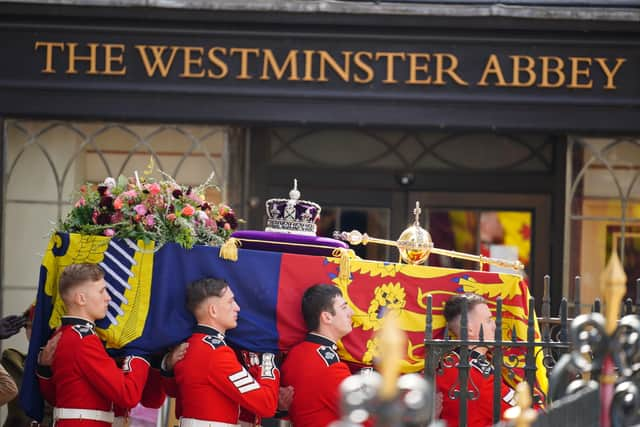Queen’s coffin floral wreath: significance of flowers on display in romantic nod to Prince Philip - explained
and live on Freeview channel 276
The wreath that is accompanying the late Queen on her final journey contains a secret romantic nod to her husband Prince Philip.
Elizabeth II’s state funeral took place at Westminster Abbey at 11am today (19 September).
Advertisement
Hide AdAdvertisement
Hide AdHer coffin was adorned with a flag, the Imperial crown, the Soverign’s sceptre and the Soverign’s orb as well as a beautiful wreath of flowers.
However the wreath was not simply decorate, but in fact contained a special nod to the Queen’s beloved late husband Prince Philip.
Elizabeth II will be taken to Windsor to be laid to rest next to her Prince.
Here is all you need to know:
What flowers are in the Queen’s funeral wreath?
The wreath which adorns the Queen’s coffin includes flowers requested by King Charles.
Advertisement
Hide AdAdvertisement
Hide AdCut from the gardens of Buckingham Palace, Clarence House and Highgrove House, the flowers and foliage have been chosen for their symbolism.
They include rosemary, myrtle, English oak, pelargoniums, garden roses, autumnal hydrangea, sedum, dahlias and scabious.
These are in shades of gold, pink and deep burgundy, with touches of white, to reflect the Royal Standard.


What was the special meaning of the wreath?
The myrtle used in the wreath was cut from a plant which was grown from a sprig of myrtle in the Queen’s wedding bouquet - in a nod to Elizabeth II’s beloved husband.
Advertisement
Hide AdAdvertisement
Hide AdPrince Philip, the Duke of Edinburgh, died in 2021 at the age of 99.
Myrtle is often seen as a symbol of a happy marriage.
Also at the King’s request, the wreath has been made in a sustainable way, in a nest of English moss and oak branches.
No use of floral foam has been used.
How the flowers capture the mood of the nation
According to founder of sustainable British florist Flowers by Imogen, Imogen Stuckes, “Myrtle is traditionally used in royal arrangements as it is a symbol of royalty itself, as well as prosperity and love. Lilies are traditionally used at funerals throughout Britain as a symbol of rebirth, purity and sympathy. They also represent devotion, which could represent the Queen’s devotion to her country.
“Gladioli symbolise remembrance, and so are a traditional funeral flower too. They also represent faithfulness, strength and pride, all things that the Queen brought to our country. Alstroemeria symbolise friendship, and many would feel that the Queen was a friend to all. Eustoma represent appreciation and gratitude – something I’m sure many people would like to show for the Queen today – as well as charisma, charm and confidence, which are a lovely nod to the Queen’s personality.”
Advertisement
Hide AdAdvertisement
Hide AdAnd she continued: “English Oak is one of our national emblems, and represents strength, wisdom and endurance, all representative of the Queen’s time serving her country. Birch symbolises rebirth and new beginnings, as we begin a new era today without our Queen.”
According to Nicola Paul, floral stylist at Paradise Blooms: “Pelargoniums or geraniums are symbolic of good health, happiness and symbolise positivity. Scabious is a popular wedding flower as it symbolises pure love and peace.”
Meanwhile, Stuckes says the display includes “pink roses which represent gratitude, love and appreciation – all things the country feels towards the Queen”.
She continues: “The colourfulness of the arrangement – rather than just traditional white – is representative of the Queen’s love of wearing colour and is joyful rather than sad. There’s also sedum which represents peace and tranquillity, a lovely choice for a funeral.”
Comment Guidelines
National World encourages reader discussion on our stories. User feedback, insights and back-and-forth exchanges add a rich layer of context to reporting. Please review our Community Guidelines before commenting.